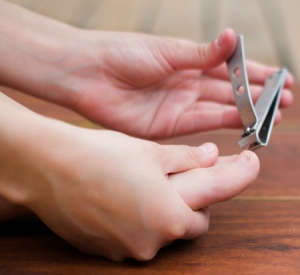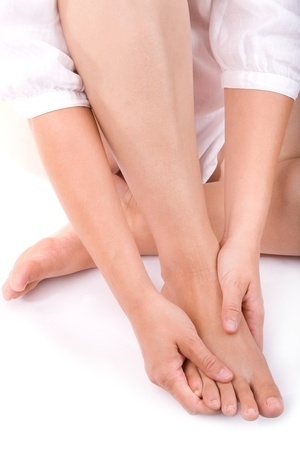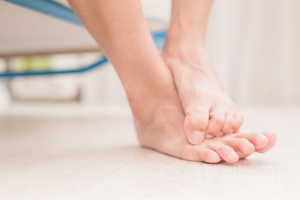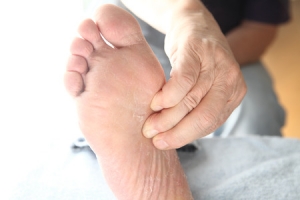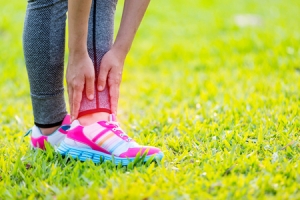Connect With Us
Blogs
10 Simple Steps to Healthier Feet
At Superior Foot & Ankle Care Center we want patients to know that being proactive about the health of your feet and ankles doesn’t have to be difficult or time consuming. April is National Foot Health Awareness Month and in its honor, we are providing these easy suggestions for taking care of your feet:
- Wash your feet every day with soap and warm water.
- Keep feet dry—change your socks if you sweat excessively. Dry between your toes after you shower. Dry feet are less likely to develop athlete’s foot.
- Don’t share shoes, socks, nail clippers, towels or other items that touch someone else’s feet.
- Inspect your feet regularly. Look for signs of foot disorders: swelling, redness, rashes, growths, lumps, discoloration of toenails and any cuts or wounds that are slow to heal.
- Don’t delay seeking treatment for foot and ankle pain. Most podiatric conditions will get worse the longer they go untreated. If you are experiencing foot pain or discomfort, make an appointment with our podiatrists, Victoria M. Foley or Dr. Constance Ornelas to get your condition evaluated as soon as possible.
- Get your foot measured professionally. Foot size can change during pregnancy and as you age. The majority of patients are wearing shoes that are too small for their feet.
- Wear shoes with good arch support. Many cases of heel pain and plantar fasciitis are caused by footwear that allows your arch to flatten, which in turn puts pressure on your heel.
- Stretch your feet. Flexing your feet, wiggling your toes and rotating your ankles all help keep feet flexible and promote good range of motion.
- Maintain a healthy weight. Many foot disorders are caused or made worse by being overweight.
- Apply sunscreen to your feet when they will be exposed—this means when you’re wearing sandals and open shoes as well as when you’re spending a day at the beach or pool.
Following these small steps will have a big impact on the health of your feet. To learn more about how to be proactive in the care of your feet, contact our Long Beach office by calling: (562) 420-9800.
Do’s and Don’ts for Getting Your Child Ready for Spring Sports
It’s time for another sports season and we at Superior Foot & Ankle Care Center want to ensure that your child gets a safe start. Below are some do’s and don’ts to help prepare young athletes to have a successful and injury-free season.
Do: start by making sure your child’s feet and ankles are in tiptop shape. Get any lower extremity pain or discomfort checked by our podiatrists, Dr. Victoria Foley and Dr. Constance Ornelas. In addition to assessing the health of your child’s feet, the foot doctor will also revisit the site of any previous trauma to be sure there is no risk for re-injury.
Do: ask the foot doctor about any accommodations necessary for chronic conditions such as plantar fasciitis or weak ankles. The foot doctor may recommend specific shoe styles or a custom orthotic device for your child.
Don’t: allow your child to go from zero to sixty on the physical activity scale. Many injuries, like Achilles tendonitis and shin splints, occur when children go directly from a period of inactivity to intense workouts.
Do: ask the coach a few weeks before the season starts to provide you with stretching and conditioning exercises and suggestions for how your child can gradually build up strength and stamina for their sport.
Do: get the right shoes for the sport your child will be participating in. This may be the single, biggest step you can take to prevent sports injuries. Get feet measured professionally and choose shoes that offer the proper support for ankles and arches.
Don’t: allow your children to wear passed on sports shoes. Shoes do conform to the shape and gait of the person who wears them. Putting your child in someone else’s shoes may do harm to their feet.
Do: check the conditions of the field, track or other surfaces where your child’s practices and games will take place. Speak up if you notice cracked pavement, uneven playing surfaces or fields that have many holes and divets. These can all lead to podiatric and other injuries.
Don’t: hesitate to contact our Long Beach office if your child experiences pain or discomfort in their lower extremities as the season progresses.
5 Tips for Overworked Feet
Do you have an occupation that requires you to be on your feet for long hours at a time? At Superior Foot & Ankle Care Center we find that nurses, teachers, construction workers and other patients with jobs that have them upright and mobile for most of the day are more likely to have foot pain and swelling and are also at a higher risk for developing podiatric disorders. Although we can’t change your job, we can offer suggestions for ways to minimize foot pain and increase your comfort level.
Get Problems Checked Out Promptly
- The majority of foot problems, such as plantar fasciitis, sesamoiditis, flat feet and metatarsalgia, are made worse by being on your feet for extended periods of time. For this reason, if your work requires this, it’s particularly important to not put off getting foot problems evaluated. Our podiatrists, Dr. Victoria Foley and Dr. Constance Ornelas will examine your feet to determine the cause of your symptoms and recommend the best treatment. The foot doctor may be able to suggest padding or an orthotic device for your shoes to help relieve foot pain. Be sure to let the podiatrist know that you have a job that requires you to spend long hours on your feet.
Choose Shoes Wisely
- Your shoe choice is critical for comfort and protection. Choose styles with good ankle and arch support and a cushioned insole. It’s a good idea to alternate your shoes as well for maximum comfort and to avoid excess pressure to one particular spot on your foot.
Stay Hydrated
- Although it may seem backwards, drinking plenty of water is one of the best ways to prevent painful edema or swelling of your feet and ankles.
Make the Most of Break Time
- When you do get a break, get off your feet for as long as you can and elevate them if possible. Do some stretching exercises and flex your feet and toes. Once your break is over, try to change your position frequently. If you are unable to sit down, at least shift your weight from foot to foot.
Compensate During Non-Work Hours
- Be sure to put your feet up when you get home from work. Choose exercise and fitness activities that don’t put additional strain on your feet. Swimming, biking and rowing are examples of physical activities that don’t put more pressure on your feet. Be sure to soak your feet if they are sore and treat yourself to a foot massage now and then to relieve pain and stiff muscles.
If you have additional concerns about your feet and your occupation, contact our Long Beach office by calling: (562) 420-9800.
Questions to Ask Before Your Podiatrist Appointment
At Superior Foot & Ankle Care Center we want all of our patients to make the most of their time in our Long Beach office. Our goal is to promptly diagnose your foot or ankle pain and devise a personalized treatment plan. Use the questions below to prepare for your appointment and ensure that our podiatrists, Dr. Victoria Foley, and Dr. Constance Ornelas have all the information they need to help you.
Where does it hurt? Knowing specifically the part or parts of your foot that are in pain will be the first step in determining your podiatric problem. It will also be helpful for the foot doctor to know if the pain is constant or intermittent and if it is sharp, stabbing, dull or burning.
When is the pain worse/better? Does exercise make the discomfort worse? If so, do bring the shoes that you normally work out in to your appointment. Do you notice that the pain is worst when you first wake up in the morning? What happens if you rest the affected foot?
What’s the history? If you’ve had a previous foot or ankle problem that you think is related to your current complaint be sure to bring any medical records, x-rays or test results to your appointment. The foot doctor will also want to get a complete medical history—many disorders can be hereditary.
Do you have questions? If there are concerns you have about your symptoms or questions about treatment options that you want answered, be sure to write them down and bring the list with you to your visit to be sure you don’t forget anything. You may also want to bring a family member or friend to the appointment to be sure you hear and understand all the information the podiatrist gives you.
A little prep work before your appointment will help the podiatrist get to the root of your foot or ankle problem more quickly. Don’t hesitate to contact us at (562) 420-9800.
Good Eats to Help Your Feet
In March, we celebrate National Nutrition Month. At Superior Foot & Ankle Care Center we believe that good nutrition has many positive benefits for your podiatric health. What’s the connection between what you eat and your feet? Read on.
Maintain a Healthy Weight—one of the most obvious benefits to eating healthy is getting to and then maintaining a healthy weight. Being overweight increases the risk and severity of many foot health problems, including:
- Arthritis
- Plantar fasciitis
- Flat feet
- Sesamoiditis
Many patients may not realize when it comes to your lower extremities, the pressure of excess pounds can be dramatic. For example, every pound you gain or lose exacts 4 times the amount of pressure on your knees.
Stay Active—in addition to the fact that it’s easier to be active when you’re not overweight, the foods you eat can also impact your energy level. Avoiding processed foods and those high in saturated and trans fats and sugars and focusing on lean protein and complex carbohydrates can increase your energy level and help you be more active.
Get the Nutrients You Need—good nutrition is about eating a varied diet. Enjoying a rainbow of produce, both fruits and vegetables will ensure that your body gets all of the many nutrients it needs. Certain fruits and vegetables like blueberries and red peppers can help fight inflammation, a common source of pain in podiatric disorders. Making choices that ensure you get the calcium you need from dairy products, leafy greens, and certain fishes will build strong bones—something that’s important to your feet since over a quarter of all the bones in your body can be found there.
Avoid Diseases that Harm Your Feet—your diet can lower your risk for certain diseases like diabetes, heart disease, and high blood pressure. Each of these conditions causes problems that can harm your feet such as poor circulation and neuropathy.
If you have questions about ways that your diet can improve the health of your feet, contact our Long Beach office by calling: (562) 420-9800. Our podiatrists, Dr. Victoria Foley, and Dr. Constance Ornelas. We want to help our patients be proactive about their health and take the necessary steps to lead active lives.
5 Foot Symptoms and What They Mean
At Superior Foot & Ankle Care Center, we urge all of our patients to inspect their feet regularly and report any unusual changes to our podiatrists, Dr. Victoria Foley or Dr. Constance Ornelas. Sometimes, however, we find out that patients put off making an appointment at our Long Beach office because the change they’ve noticed just doesn’t seem that serious. Small changes can mean big foot problems, and your feet can also act an “early warning system” for diseases that can affect your whole body. Below are some changes in your feet and what they may mean:
- Red skin. Although short-term redness of the feet could just be due to temperature change or an allergic reaction to your laundry detergent, consistent redness can mean something more serious. Infections, such as athlete’s foot, can start with redness of the skin and an itchy rash. Consistently red or inflamed feet can also be a sign of the autoimmune disease of lupus.
- Black toenail. Unless you’ve recently stubbed your toe or you’re a runner, a black or discolored toenail is characteristic of a fungal infection. These may not be painful initially but will continue to progress and are contagious if not treated.
- There are several diseases which can cause excess fluid buildup (also called edema) in your legs and feet. These include: kidney or liver failure, heart disease and diabetes. If you are pregnant, a certain amount of swelling is normal but if in the last trimester of your pregnancy you experience sudden or excessive swelling, it may be a sign of a preeclampsia, a serious condition that requires immediate treatment.
- Cold feet. If your feet are always cold, regardless of the season or temperature, it can be an indicator of poor circulation. There are several possible causes for this, including diabetes, anemia and an underactive thyroid.
- Everyone gets a foot cramp occasionally, but if you are getting them regularly, it’s something to get checked out. In some cases, it may simply be a case of dehydration or a lack of certain minerals in your diet like magnesium, potassium or calcium. On the other end of the spectrum, however, ongoing foot cramps can be an indicator of nerve damage.
If you notice anything different about your feet or ankles—even if the changes are not painful or dramatic—contact us as soon as possible at: (562) 420-9800.
What’s this Lump in My Arch?
Patients usually panic when they find a lump in their foot (or anywhere else on their body for that matter). At Superior Foot & Ankle Care Center we urge patients to arrange an appointment with one of our podiatrists, Dr. Victoria Foley or Dr. Constance Ornelas to get any unusual growths checked out promptly. One that we can put your mind at ease about, however, is a plantar fibroma.
Benign but Challenging
Plantar fibromas are benign fibrous tumors that develop in the arch of your foot. They are embedded in the plantar fascia, the long ligament that stretches along the bottom of your foot. The first and most obvious sign of a plantar fibroma is being able to feel a hard lump in the arch of your foot, which may or may not be painful, at least initially. This lump may stay the same size or grow over time, and additional fibromas may also grow. The condition may occur in one or both of your feet. Because of their location, plantar fibromas can cause pain and pressure in multiple areas of the foot.
Treatment Options
If you find a lump in the arch of your foot, the podiatrist will examine your foot and also order x-rays or an MRI to confirm the diagnosis. Non-surgical treatment options are aimed at reducing pain but cannot eliminate the fibroma. Corticosteroid injections may be recommended in an attempt to reduce pain and inflammation and shrink the fibroma, but the results are often temporary. Traditional surgery has the risk of nerve damage. A new development in the treatment of fibromas is cryosurgery. This procedure, done on an outpatient basis, freezes the tumor and shrinks it with little to no post-surgical pain or complications.
To learn more about this condition, contact our Long Beach office by calling: (562) 420-9800.
Take a Total Body Approach to Health
At Superior Foot & Ankle Care Center, we support a whole-body approach to foot health. February is American Heart Month. Part of keeping your heart healthy is eating correctly to maintain a healthy weight and staying active. Your feet play a key role in an active lifestyle. But, if the rest of your body isn’t being properly cared for, your feet can’t do it on their own. Below are areas that need your attention to in order to have good heart, foot, and overall body health.
Stress Busting—negative stress not managed correctly can lead to a lack of motivation and caring about our health. It’s easy to throw aside your exercise program because you’re in a bad mood or sad. Cultivate tools that can help you reduce stress and get you back on track:
- Practice positive self-talk. If you stop and listen, we’re talking to ourselves all the time in our heads. When stressful things occur, you can start to change your outlook by changing your self-talk. Instead of “I can’t believe this is happening,” try “Okay, I can handle this. The first step is…” or “There’s no way I can do this,” change to “Where can I find help with this issue?”
- When stressful situations hit, put some space between yourself and the situation. Take a walk, spend some time with a pet or even count to 10 and do some deep breathing exercises to help you get under control.
- Cultivate ongoing stress-reducing activities such as hobbies, prayer, getting together with friends, reading, home improvement or gardening project.
Sleep it Off—not getting enough sleep (and enough is defined as 7-9 hours a night) can negatively impact your mood, eating habits, mental sharpness, physical functioning and more. Try some of these tips for a better night’s sleep:
- Set your cell phone on silent or do not disturb and don’t keep it close to your bed. Falling asleep to your Facebook feed is not restful.
- If you like to fall asleep while watching television, make sure you set it on a timer to go off. Studies show that sleep is less deep when a flashing screen plays all night in your room.
- Take time to wind down before bed. A cup of decaffeinated tea, warm shower or bath, and some light reading are all excellent ways to relax and prepare for sleep. Establishing a routine before bed helps signal your body it’s sleep time.
Your feet work in conjunction with your heart and the rest of your body to achieve good health. If you have concerns about your feet, make an appointment to see one of our podiatrists, Dr. Victoria Foley or Dr. Constance Ornelas, at our Long Beach office by calling: (562) 420-9800.
Common Reasons Exercise Programs Fail
At Superior Foot & Ankle Care Center we know the importance of exercise to your feet as well as the rest of your body. That’s why we applaud patients who make a resolution to get in shape in the New Year. Too often, however, by the time February rolls around many exercise plans have already been shelved. Below are some scenarios that can bring fitness plans to a halt and how to work around them.
“Let’s do this! I am going to work out every day to get in shape fast no matter what it takes.”
Not so fast, or you’ll likely end up with an injury. Achilles tendonitis, ankle sprains, and shin splints are just a few of the conditions that can be caused by doing too much too quickly. Not to mention that an overly ambitious start, especially if you’re out of shape, can lead to fatigue and discouragement before you even really get started. The best bet for long-term success is to do an activity or program that allows you to start slowly and gradually increase the level of your workout.
“I started a running program a few years ago and still have my shoes—yay! I won’t have to go out and buy new ones.”
Footwear is one of the most important factors in the success of an exercise program. Getting fitness shoes that are designed for the sport or activity, you’ll be doing is key. However, foot size can change over time. It’s best to get your foot measured professionally and try your shoes on to make sure they are still comfortable.
“I have a bunion, but I think if I put a pad over it I should be able to exercise without a problem.”
Before starting a new exercise program, it’s always best to consult your general practitioner and also your podiatrist. Our foot doctors, Dr. Victoria Foley or Dr. Constance Ornelas, will examine your feet completely. If you have a chronic foot problem, the podiatrist can recommend shoe styles and make suggestions for how to best accommodate your condition. In some cases, a custom orthotic device can increase comfort and performance.
“I’m going to join a gym—there are lots of good deals available now.”
Take the time to consider your likes and lifestyle. A gym is a good option if you like the classes and machines offered and you need to schedule around your work. Consider if you want a more social setting or if you like to work out alone, if you prefer an indoor or outdoor activity and how much time you can devote to your fitness plan. You’re more likely to stick to a plan that suits your interests and your availability.
If you experience any foot or ankle pain or discomfort when exercising, contact our Long Beach office by calling: (562) 420-9800.
How to Have Healthy Feet
January is a good time for starting new habits, and we at Superior Foot & Ankle Care Center would like to urge patients to make this the year that you commit to better care of your feet. We believe in educating our patients to be proactive about the health of their feet. There are many ways that you can reduce your risk of injury and foot disorders and improve your podiatric health. Below are some suggestions:
- Wash your feet every day with mild soap and warm water. Dry them thoroughly, with particular attention to the area between the toes. This will significantly reduce the risk of athlete’s foot.
- Don’t walk barefoot. Out in public, walking without shoes increase your risk of coming in contact with a fungal infection. Even at home, you can protect your feet from stepping on sharp objects by keeping them covered.
- Get in the habit of inspecting your feet on a regular basis. The best outcomes for foot disorders occur when they are treated in their earliest stages. Being vigilant about reporting changes in skin or nail color, swelling, bumps or growths, bruising and cuts that don’t seem to be healing to our podiatrists, Victoria Foley or Dr. Constance Ornelas, can save you from prolonged and invasive treatments.
- Making wise shoe choices. Did you know that the single most significant step you can take to improve the health of your feet is choosing good shoes? Styles with roomy toe boxes that don’t constrict your toes, adequate arch support and laces for a firm fit can reduce the risk of falls, joint conditions, and toe deformities. In addition, getting away from wearing high heels can prevent neuromas and lessen the chances of bunions and several other podiatric problems.
- Apply sunscreen, not just on beach days but any days when the bare skin of your feet will be exposed in open sandals or shoes to the sun. The skin on your feet is just as susceptible to skin cancer as the skin on the rest of your body.
- Take care of toenails. Keep your nails trimmed straight across and not too short to prevent ingrown toenails from developing.
Better foot care needn’t be complicated or time-consuming. A few simple changes in your daily regimen can make a world of difference. If you have questions regarding the care of your feet, contact our Long Beach office today by calling: (562) 420-9800.
